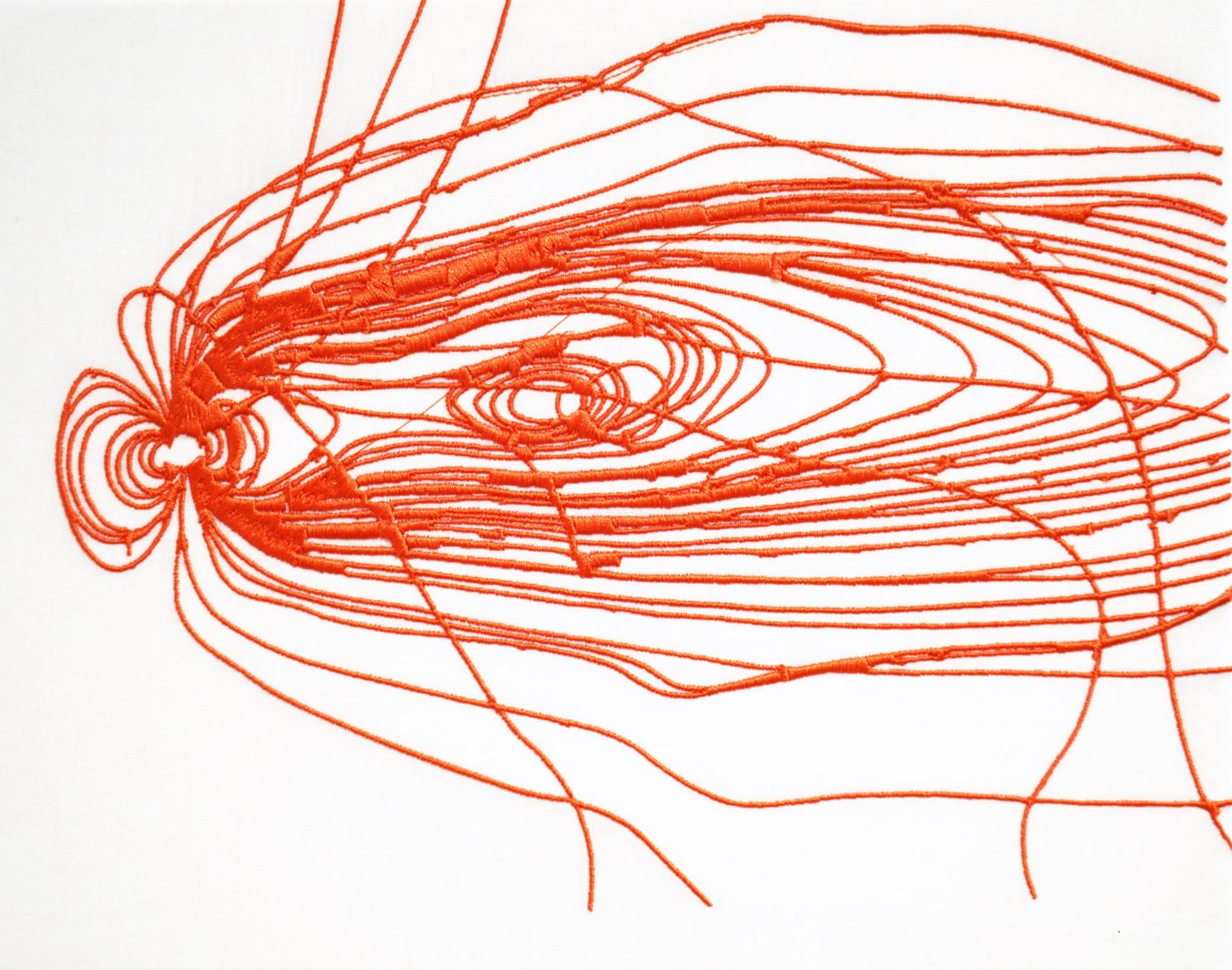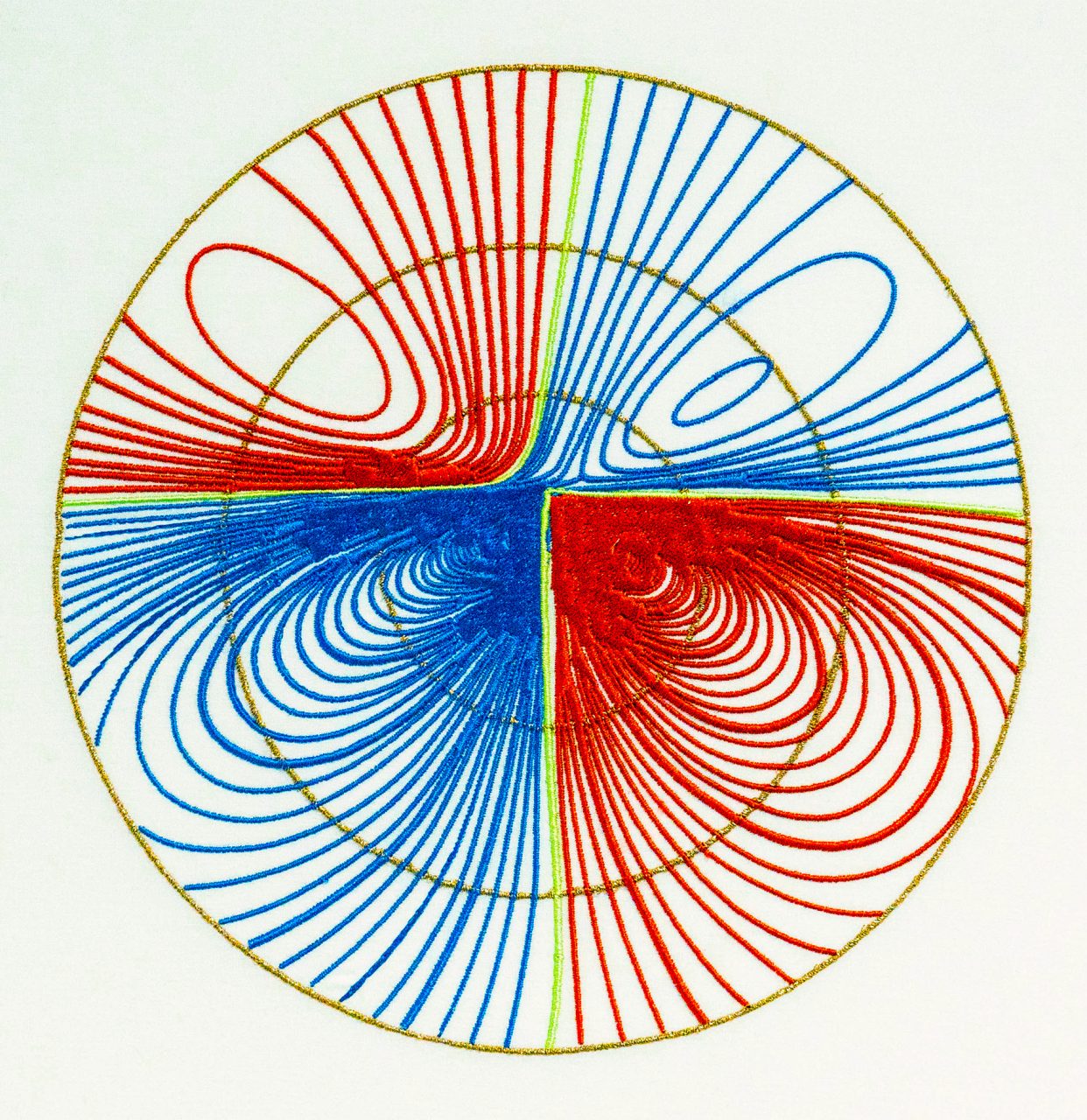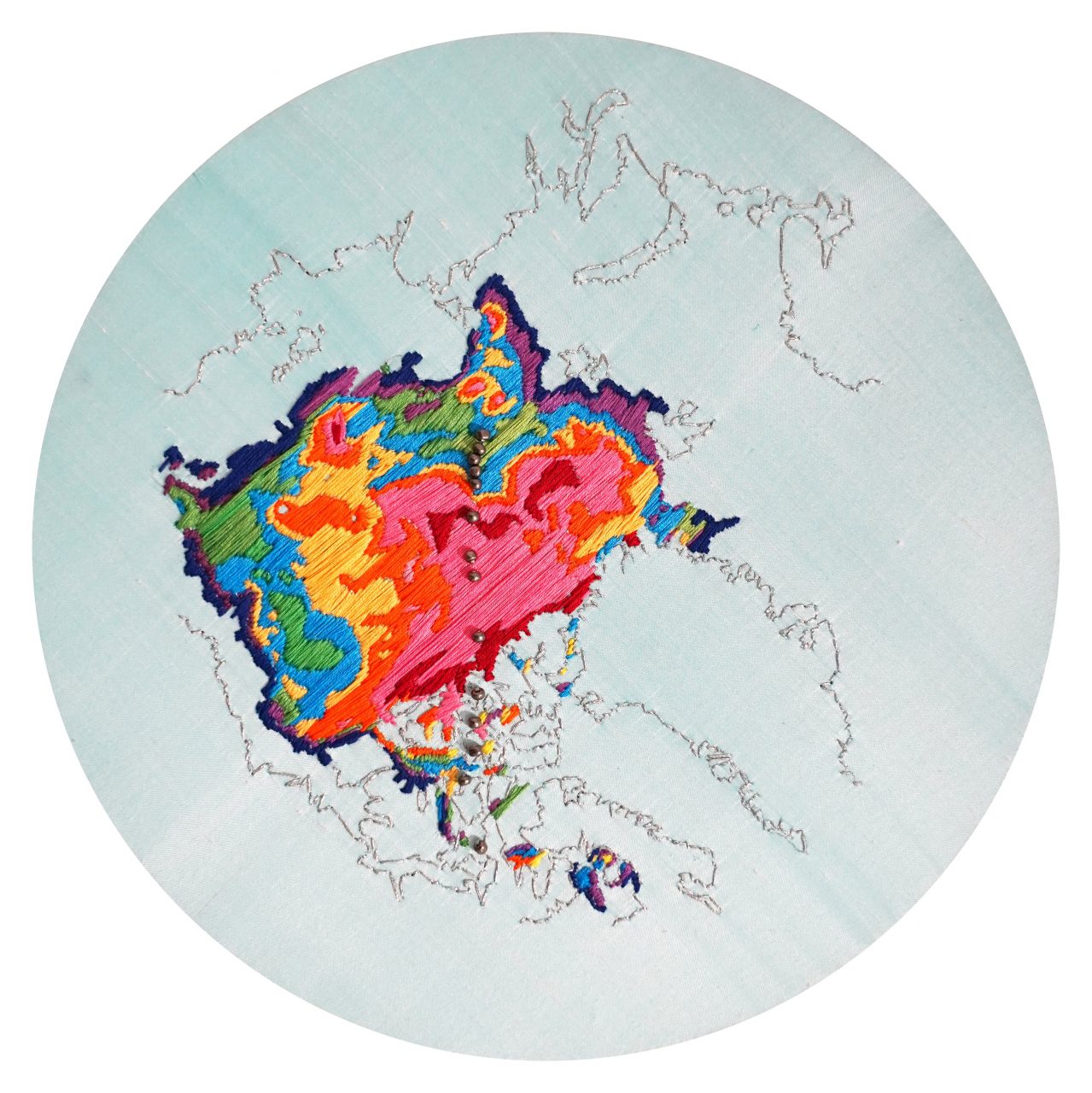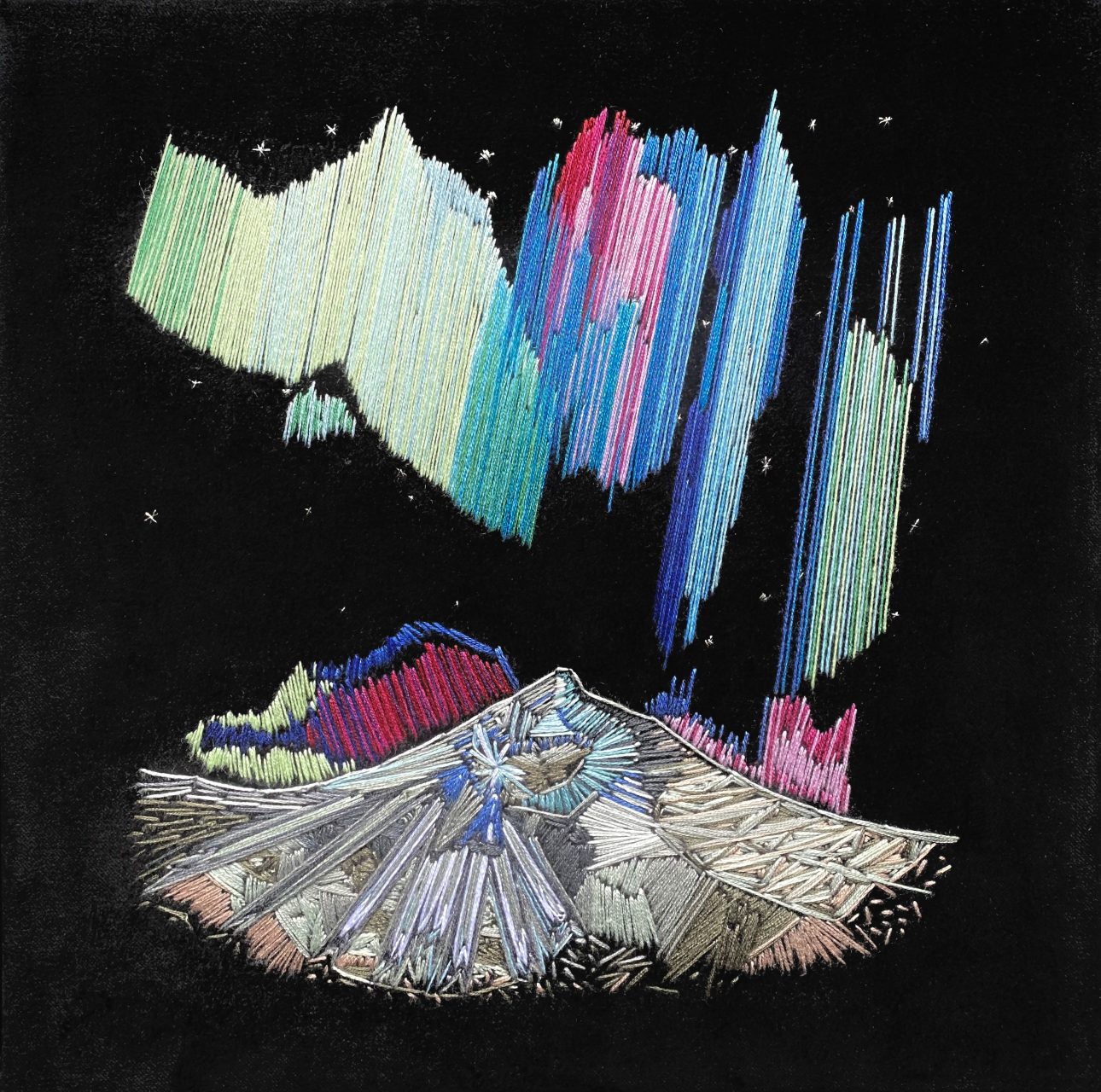Understandings of Earth’s polar regions are sutured with motifs of the Anthropocene in regard to an uncertain future, as a focal point for climate change impacts, anxieties, and associated geopolitical tensions. The Poles also attune us to place—directionally on the planet’s surface, seasonally in relation to animal migrations, and to our connections with the solar system. Polar spaces produce material, social, and cultural meaning in part through a set of spatial variables—orientation and direction—which position and mediate planetary relations: (Ant)arcticness, polarity, north- and southward. These spatial dichotomies dominate our understanding of the planet’s extremities, and this directionality is largely a function of magnetic fields.

While the Poles, and even more so, magnetic fields, are primarily viewed and presented through a scientific lens, they are also mediated through everyday practices and experiences. Technocultural studies scholar Douglas Kahn argues that many philosophers “leapfrog over lived experiences of electromagnetism and head straight to theoretical physics and the observably limited behaviors of quantum realities,” and that this predilection “has left everyday lived electromagnetism, from communications to the sun, to others.” (2013, 10, emphasis in original) In this collaboration, we use embroidery to remediate the magnetic subset of electromagnetic phenomena in order to process physics through bodily practices. We consider the oft-ignored scales and aspects of the personal and political facets of earthly and lived physics, aiming to use “creative pieces [to] challenge the normative spaces and practices of disciplinary knowledge-making.” (Marston and de Leeuw 2013, iv) The embroidery in Figure 1, which represents the magnetic field of a bar magnet dipole in red and blue, uses silver metal threads on the left. On the right, blue metal thread radiates outward, representing the field produced by Earth’s molten core. This work explores the physics of the magnetosphere and its importance to both planetary and daily life—as Mark Kaufman describes it, an “intimate relationship between the magnetic field and life.” (2018, n.p) Through vignettes we call magnetograms, we attempt to draw close and make familiar that which seems distant and perplexing.
Our collaboration began in 2021 during the pandemic lockdowns. As a geographer in Germany and an artist in California, we convened virtually, sewing embroideries as a way to (re)present ephemeral magnetic phenomena, fields, and orientations visually, through textiles. We researched planetary and lived magnetism through diagrams and schematics, and shared our discoveries, embroidery techniques, and progress. We independently chose topics and imagery that helped us imagine, envision, and then compose magnetic moments. Each embroidery is fairly small, creating intimate and detailed reflections of our explorations.
Making/Mediating Magnetograms
The famous theoretical physicist Richard Feynman said, “I have no picture of this electromagnetic field that is in any sense accurate…. So if you have some difficulty in making such a picture, you should not be worried that your difficulty is unusual.” (Feynman as quoted in Kahn 2013, 10) This project is an experiment in the exploration of multiple manifestations and visualizations of this ephemeral phenomenon, to help ourselves and others imagine and engage this abstraction, and to materialize it in textile forms. While we are drawing from common scientific depictions, we are not fixated on accuracy. We seek to explore the difficulty of the representation, mediation, and scale of earthly and lived physics.
Textiles have a long history of recording stories. Hand stitches transform abstract ideas into a physical process and object. We chose to embroider, partially because we enjoy the medium, but also because it reflects the long history of embroidery as a method of storytelling. Textiles do not exist without a narrative, and they have been used before to chronicle cosmic affairs.
One example of narrative embroidery is the Bayeux Tapestry, as seen in Figure 3. This 70-meter-long embroidery depicts the detailed conquest of England by William, Duke of Normandy, in 1066. Included in the narrative is Halley’s Comet. King Harold and a group of amazed Englishmen point toward the flaming orb streaking through the sky. The cosmic is grounded, given context in its earthly orbital relations and as a spectacle to earthlings.

Right: A section of Historja (Image courtesy of Michael Alstad, ickr user malstad, CC BY-NC-SA 2.0).
Further poleward, the Sámi artist Britta Marakatt-Labba’s embroidery Historja depicts the Sápmi region and its history dating back centuries. Similar to the Bayeux Tapestry, Marakatt-Labba’s 24-meter-long embroidery is sewn on a piece of woven linen. It renders the oral traditions and polar life of the Indigenous Sami people. Collective memories are made visible and given form. Matthew Rana describes this work as embodying the “tensions between representational and symbolic, figurative and figurable” as they intertwine “material reality with supernatural forces.” (2019 n.p.)
Just as one fashions transient events into a cloth chronicle, we materialize magnetic moments into a tangible and functional craft. Using art as a catalyst for contextualizing the magnetosphere, we think with our fingers to mediate earthly emanations, using sewing to reflect on process and theory. This project is an experiment—with theory and threads, fields and fabrics, methods and materials—to explore Earth’s magnetosphere. We stitched imaginaries of the circumpolar world into something material. Our embroideries, unlike Historja and the Bayeux Tapestry, are not linear narratives, but disconnected vignettes. We have each contributed segments, with the potential to stitch them together into a shared, intersecting story, when we can be together in the same space again.
Embroidery is a very accessible medium for makers, even during pandemic lockdowns. Tools such as needles, thread, and scissors are easily obtainable. We chose to use a range of fabrics including, cotton, velveteen, and silk as bases for the stitchwork. Some are patches made of cotton, a durable and common fabric, embellished with metallic threads made of real silver. Others use a digital sewing machine, from computer-generated data that was carefully plotted and stitched.

Interplanetary
Our magnetosphere manifests from Earth’s spinning core of iron, generating a planetary field. In this way, it connects the planetary surface to its deep interior, as well as to other bodies in the solar system, in particular the Sun. This spin of liquid metal innards rotates about Earth’s axis, generally producing a field aligned between the poles, similar to a household magnet. While the field is continuous, with a magnitude at every point in space, diagrams usually represent it via discrete lines, creating a flattened and generally topographical schematic of this dynamic planetary enclosure. We remediate illustrations of these elementary scientific abstractions into something textured, reflective, and tactile.
The individual magnetic field lines shown in diagrams are both a construct used to represent a continuous magnetic field and often shown in a smoothed, cartoon style that conceals the actual complexity exhibited by the magnetosphere. As O’Neil describes, “if the conditions are right, the Sun’s magnetic field may breach Earth’s magnetosphere, causing the two to snap and reconnect, effectively creating a temporary magnetic marriage between the Sun and Earth.” (2020, n.p.) These manifestations bridge the boundary of cosmological and earthly. The orange contours in Figure 4 depict the warping contortions from a NASA simulation of magnetic field reconnection. The linework was vectorized using design software, and then sewn by a digital embroidery machine. The strands of individual magnetic field lines are composed of dense computer-generated stitches that follow the contours of the reconnection simulation.
Cosmic Refuge
The importance of Earth’s magnetic field is that it acts as a cosmic shield, protecting biological bodies from cosmic ray bombardment and ensuring our atmosphere is not swept away by solar winds—a shelter from extraterrestrial aeolian erosion. This is what happened to Mars. It’s slightly smaller mass bled the core’s heat, solidifying as it cooled. Without this conducting fluid, the magnetic bubble popped and the oceans and atmosphere, no longer shielded, escaped into the void. While Earth’s magnetic field has a strength of just a few microteslas at the planet’s surface (Weigel 2018)—two to three orders of magnitude less than that of a refrigerator magnet—it is enough to cocoon us safely within its refuge, preventing the excoriation of life-essentials.

The continued dynamism of our planet keeps it habitable and sustains unique relationships between Earth and the broader solar system, as well as planetary connections between the surface and core, the poles and lower latitudes, and spatial fields of human and non-human navigators. Magnetic relations orient people, particles, plants, and pigeons to place and planet. And while Earth acts like a giant bar magnet, these forces are invisible to humans. Their impacts, while having widespread ecological, cultural, and socio-political implications, are rarely considered outside the realm of physics or a few applied sciences. Animals use the field to migrate, but the field itself is migrating. Figure 5 gives a close-up view of the homing pigeon surrounded by a thin magnetic field made of thread that orients and directs the bird over long flights. Pigeons’ detection of the magnetic field is woven into their complex navigation system. People have long used homing pigeons to deliver discrete messages across enemy lines, because of the birds’ keen ability to find their way home.
Animal Sensoria
Humans have known for thousands of years that a magnetized piece of metal will align along a north-south orientation—knowledge used to navigate, migrate, and explore land, sea, and sky. Of course, it is not only human animals that use Earth’s magnetic field in this way. Non-human animals do so directly, without the technological mediation we need, exceeding the human in this sensory capacity. As behavioral biologist John Phillips explains, “organisms as diverse as hamsters, salamanders, sparrows, rainbow trout, spiny lobsters, and bacteria all do it…. I would go so far as to say that it’s nearly ubiquitous.” (quoted in Tyson 2003) Migrating animals use magnetic fields to orient themselves, some traveling hundreds, or even thousands, of miles to their destinations. Figure 6 uses hand embroidery to depict a spawning salmon, stitched with blue and red speckles, sensing a magnetic topography represented by gold thread.

Salmon famously swim from their birthplace in small freshwater mountain streams down into deep and salty seas, where they spend their adult life. Returning to their birth stream, after years away, is an extrasensory journey using the angle and strength of the magnetic field. This navigation biology to return is a powerful driving force. It may also be a deep genealogical trait. A lab in Oregon tests such possibilities, using coiled copper wires to lure tank fish into orientation with the local field. The experiment seeks to determine the exact mechanics and duration of salmon knowledge of place (Scanlan et al. 2018). Understanding this becomes increasingly important with the growing number of farmed fish, some genetically altered, which may inherit an intergenerational pull to a long-lost breeding stream, as epigenetic inheritance allows them to remember somewhere they’ve never known.
The biological interpretation of magnetism for navigation is called magnetoception (not to be confused with biomagnetism, when an organism produces a field, or magneto biology, the impact of a field on an organism). As shown with salmon, understanding magnetoception is a developing field of science, previously considered a quasi-science, still with much to discover (Kaufman, 2018). There are even ongoing studies to analyze whether humans may have remnant magnetic senses. Human brains do contain magnetite, and our eyes contain cryptochrome, which is what aids magnetoception in other animals. Beyond the conventionally labeled five senses, as professor of geobiology Joseph Kirschvink points out, “gravity, temperature, pain, balance, and several other internal stimuli” are also important to human experiential knowledge. Perhaps “geomagnetic field sensors should also be there representing not [our] sixth sense but perhaps the 10th or 11th.” (quoted in Perkins 2019)

Geomagnetic Geopolitics
Earth’s geomagnetic field is used for navigation, attitude, and heading referencing systems for military, scientific, and civilian enterprises. The U.S. Air Force is experimenting with using a magnetometer for navigation in case GPS satellites are destroyed, jammed, or spoofed (Mizokami 2021). This is just another way, as Wayne Chambliss argues, that “the military has tried to recruit the Earth itself as an informant.” (2020, 67) TheWorld Magnetic Model (WMM), a joint product of the U.S. National Geospatial-Intelligence Agency (NGA) and the U.K. Defense Geographic Centre (DGC), keeps track of variations between the north magnetic pole and the true, or geographic, North Pole. The difference between these is called magnetic declination, and calculating it is essential for accurate navigation.
While magnetic pole drift is not unusual, due to liquid core density fluctuations deep beneath Earth’s surface, changes can be irregular and hard to predict. The model was forced to do an unscheduled update in 2019 because of erratic behavior in the field that is not currently understood (Witze 2019). The digital embroideryin Figure 7traces the lines of declination at the North Pole. The WMM’s representation of the magnetic north field was carefully vectorized into four colors. Positive values of declination are sewn with red thread and negative charge in blue. The thin agonic line, an imaginary line that passes through the north magnetic pole and the geographic north pole, is outlined in fluorescent yellow thread. The lines of latitude encircle the magnetic fields with metallic thread.
Melting Ice Archives
The history of Earth’s magnetosphere, a field called paleo-magnetism, investigates sporadic polar reversals. These reversals are archived in the ice. Just like in oceanic sediment cores or stratified geologic bands, magnetic particles of dust and soil in the freezing water are “aligned with the Earth’s magnetic field at the time they are trapped in place.” (Weizmann Institute of Science 2020, n.p.) These frozen chronicles tell the story of Earth’s changing geomagnetic history as well as many other biological and physical phenomena—a geologic tapestry of deep time. This is how we know that Earth is long overdue for a pole reversal, a messy process in which the planet’s magnetic fields “morph and push and pull at one another” until the north and south poles eventually switch (Dunbar 2011).

Just as shifts deep in Earth’s core are moving the magnetic poles, changes in the distribution of mass on Earth’s surface are displacing the geographic poles. While the position of the planet’s spin axis has known wobbles, glacial melt and depleted water storage have contributed significantly to a shift of mass away from ice near the poles, lakes, and aquifers on land, to more mass in the global oceans. “If ice disappears from one part of the spinning Earth and resettles elsewhere as water, the planet shifts on its axis toward the place where it lost mass.” (Howard 2016) These dual anthropogenic impacts of climate change and water depletion are leading to the redistribution of mass equatorward, causing the poles to wander. The geographic North Pole has been migrating at a dramatic rate for the last fifty years. The direction of drift has been unpredictable, but closely tracked. Amidst polar motion, drift, and reversal over multiple time scales, the poles seem to offer disorientation as much as orientation.
In Figure 8, the hand-embroidered Migration visualizes changing Arctic sea ice thickness and the shifting magnetic north pole. Onyx-like beads represent migration of the magnetic north pole away from Canada and toward Siberia. The embroidered map freezes the ice levels on September 10th, 2021 in time, the date the sewing began. The data of ice thickness is color-coded, where dark red thread indicates the greatest amount of sea ice at four meters and the thinnest area, about a quarter-meter, uses dark blue thread. The vibrant embroidery thread sits above the sleek surface of the ice-like blue silk. Outlines of polar landmasses are sewn with metallic thread.
Borealis
Magnetic movement not only migrates but creates a rhythm of dancing lights through the sky. Charged particles travel along magnetic field lines before colliding with atmospheric gasses, emitting molecule-dependent colored light, green from oxygen, red or blue from nitrogen. The aurora luminescence along the topography of the fields makes visible these “features of Earth that make life possible.” (Kaufman 2018, n.p.) Pertaining to human perception, the magnetosphere is most accessible in its manifestations in the antipodal night skies. The magnetic field is strongest where the lines converge, producing complementary aurora polaris, borealis in the north, and australis in the south. Geomagnetic storms release electromagnetic waves, causing a cascade of photons colliding with the ionosphere, the high atmosphere that is electrically charged. In Figure 8, an aurora is sewn on velveteen, a rich and dense fabric that evokes a sense of the void, broken only by the scintillating lights stitched into the sky. The colours of the lights span the full spectrum against a starry background.

In this work, we have tried to create common threads between tactile arts and the ephemeral magnetosphere to explore lived magnetisms. As Kahn describes it, such experiential physics are “a messy practice resulting from an asynchronous amalgam of perceptual experiences, developing vernaculars and discourses, technologies, and scientific knowledge.” (2013, 10) From manifesting invisible fields to depicting animal magnetoception, our magnetograms use embroidery as a simple technology to offer a tactile vernacular that converses the entanglement of life with not-life. As Tom Nurmi explains, “the elegant symmetries that persist between biotic and abiotic spheres of being might offer a conduit between science and art that clarifies our reliance on, and obligation to, unfamiliar nonhuman worlds.” (Nurmi 2020, p. xiii) As our embroidery stitches filaments and knots into silk and velveteen to compose each image, the field lines and particles are joined to sensory organs and planetary habitats to fashion this life-world.
Bibliography
Dunbar, Brian. “2012: Magnetic Pole Reversal Happens All The (Geologic) Time,” NASA, November 30, 2011. https://www.nasa.gov/topics/earth/features/2012-poleReversal.html
Chambliss, Wayne. “Spoofing: The Geophysics of Not Being Governed,” in Voluminous States: Sovereignty, Materiality, and the Territorial Imagination, Franck Billé, ed., 64-78. Durham and London: Duke University Press, 1920.
Howard, Brian C. “Climate Change Is Moving the North Pole,” National Geographic, April 8, 2016. https://www.nationalgeographic.com/science/article/160408-climate-change-shifts-earth-poles-water-loss
Kahn, Douglas. Earth Sound Earth Signal Energies and Earth Magnitude in the Arts. Berkeley, CA: University of California Press, 2013.
Kaufman, Marc. “The Northern Lights, the Magnetic Field and Life” Many Worlds, February 19, 2018. https://manyworlds.space/2018/02/19/the-northern-lights-the-magnetic-field-and-life/
Marston, Sally A. and Sarah de Leeuw. “Creativity and Geography: Toward a Politicized Interventio,.” Geographical Review, Volume 103, Issue 2, 2013, iii–xxvi. https://doi.org/10.1111/gere.12001
Mizokami, Kyle. “The Air Force Is Going to Navigate Jets Using Earth’s Magnetic Field,” Popular Mechanics, July 9, 2021. https://www.popularmechanics.com/military/aviation/a36973321/air-force-magnetic-field-navigation
Nurmi, Tom. Magnificent Decay: Melville and Ecology. Charlottesville, VA: University of Virginia Press, 2020.
O’Neil, Ian. “Earth’s Magnetic Field Just Hit a Phantom Speed Bump,” astroengine.com, January 7, 2020. https://astroengine.com/category/physics/solar-physics
Perkins, Robert. “Evidence for a Human Geomagnetic Sense,” Caltech Weekly, March 18, 2019. https://www.caltech.edu/about/news/evidence-human-geomagnetic-sense
Rana, Mathew. “Opacity at the Bottom of the Mirror,” Kunstkritikk, January 8, 2019. https://kunstkritikk.com/opacity-at-the-bottom-of-the-mirror/
Scanlan, Michelle M., Nathan F. Putman, Amanda M. Pollock and David L. G. Noakes. 2018. “Magnetic map in nonanadromous Atlantic salmon.” Proceedings of the National Academy of Sciences, October 8, 2018. https://doi.org/10.1073/pnas1807705115
Tyson, Peter. “Animal Magnetism,” Nova, November 1, 2003. https://www.pbs.org/wgbh/nova/article/magnetic-impact-on-animals/
Weigel, Brandon. “Giving Mars a Magnetosphere: An addendum to ‘Terraforming Mars’,” Our Space, February 28, 2018. https://medium.com/our-space/an-artificial-martian-magnetosphere-fd3803ea600c
Weizmann Institute of Science. 2020. “The magnetic history of ice,” phys.org, June 29, 2020. https://phys.org/news/2020-06-magnetic-history-ice.html
Witze, Alexandra. “Earth’s magnetic field is acting up and geologists don’t know why,” nature.com, January 9, 2019, 143-144. https://www.nature.com/articles/d41586-019-00007-1
Katherine G. Sammler is a geographer, formerly trained in physics and atmospheric sciences, leading the Marine Political Ecology group at the Helmholtz Institute for Functional Marine Biodiversity in researching the role of knowledge, law, and power in dening global commons, access, and environmental justice in oceans, atmospheres, and outer space.
Lauren Hartman is an artist and a professor of visual art at the California State University Maritime Academy. She combines embroidery, sculpture, and archival research to document the shifting landscape of the Arctic. Her work has been exhibited in international natural history museums and galleries.
Katherine G. Sammler is a geographer, formerly trained in physics and atmospheric sciences, leading the Marine Political Ecology group at the Helmholtz Institute for Functional Marine Biodiversity in researching the role of knowledge, law, and power in dening global commons, access, and environmental justice in oceans, atmospheres, and outer space.
Lauren Hartman is an artist and a professor of visual art at the California State University Maritime Academy. She combines embroidery, sculpture, and archival research to document the shifting landscape of the Arctic. Her work has been exhibited in international natural history museums and galleries.
